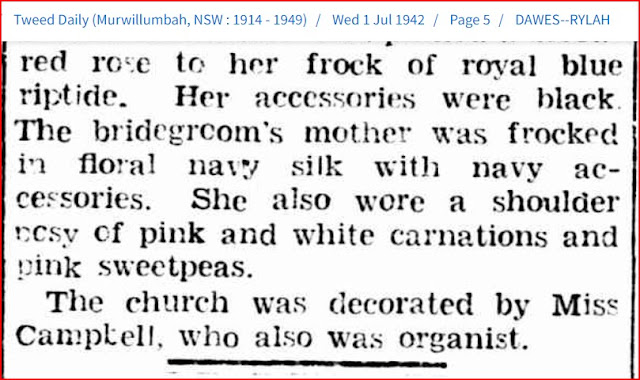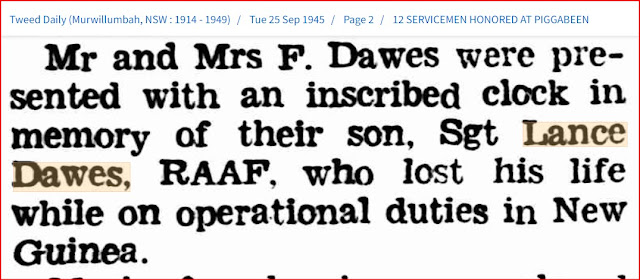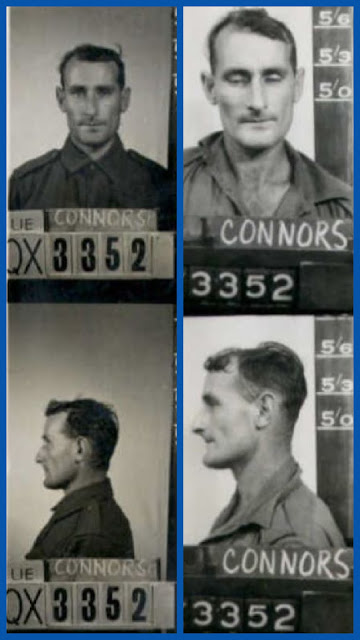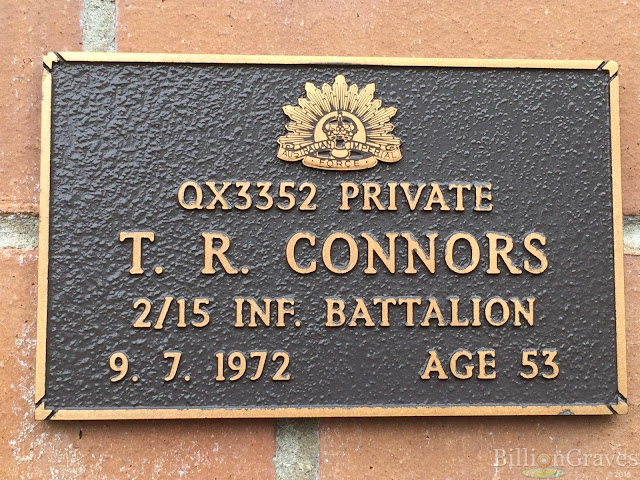This post tells the story of my paternal 3rd cousin once removed, Lance Dawes (1917 - 1943).
Our common ancestors are: James Hukins and Susannah Fullagar (my 3x great grandparents).
 |
| Lance Dawes - WW11 enlistment photo |
Recently I've been doing a lot of research about the family tree members who fought in World War 11, and whilst it was very heartening to see that the majority of them made it home to their loved ones, I found a small group of men who tragically set off to serve overseas and never returned.
Lance was born in the town of Murwillumbah, New South Wales, in 1917. He was the fourth of six children born to Frederick Dawes and Susan Charlotte Timms.
Before the birth of Lance, his mother Susan had given birth to Audrey in 1912, Cecil in 1914 and Netta in 1915. Then following the birth of Lance, Hazel was born in 1919 and Wilfred came along in 1922.
Records (his RAAF air crew application) show that Lance attended the Murwillumbah Primary School until the end of 1929.
Lance's name appeared on a list of primary school students who had qualified for entrance to the Murwillumbah High School, published in early 1930 in the newspaper, The Northern Star. He then attended Murwillumbah High School from 1930 until May of 1932 when he turned 15.
Lance's father was a dairyman and established his own dairy farm in the area.
Piggabeen had predominantly been a dairy farming town throughout the early 1900s, but by the time the Dawes family had re-located there, other industries had begun to flourish. The rich volcanic soil in the region was particularly suitable for banana growing, and by the beginning of World War 11, Lance had a small farm of his own on which he grew bananas.
In October of 1940, Lance completed his application a an Airman with the Royal Australian Air Force.
In November of 1940, at the age of 23, Lance submitted his application for air crew selection in the Royal Australian Air Force.
Some of the details included on his application were his occupation (banana grower), sports and games he had played (cricket and tennis) and the fact that he had not completed an Intermediate or Junior Public Examination. He had deferred his education after completing a term examination in April of 1932.
After sending off his application, there was a bit of a wait until Lance was actually called up to serve.
In the meantime, in May of 1941, Lance enrolled in the R.A.A.F. Reserve and was posted as Air Crew to Group V of the Reserve. His Reserve Badge No. was 3524.
Then an item appeared in a local newspaper, dated September 27, 1841, stating that Lance "has received his call-up for the R.A.A.F. and will report for duty shortly".
 |
| Attestation papers completed in October of 1941 |
 |
| Enlistment Photo 1941 |
On the 12th of October 1941, at the age of 24, Lance travelled to the Recruiting Centre in Brisbane, Queensland and completed his attestation forms to enlist with the R.A.A.F.
He was the first of the family to enlist for wartime service.
Younger brother Wilfred enlisted with the RAAF just a couple of months later, in January of 1942, aged 19. Older brother Cecil enlisted in April of 1942 with the CMF, aged 28.
There was quite a lengthy period of training ahead for Lance, from October of 1941 to August of 1942.
 |
| A list of Lance's postings from his war service record |
Lance trained at 3 I.T.S. - No. 3 Initial Training School - at Sandgate in Brisbane, Queensland, towards the end of 1941. This initial training would have taken two months to complete.
He was then mustered to 3 W.A.G.S. - 3 Wireless Air Gunner School - located at Maryborough, Queensland, in December of 1941. There he completed the seven-month course that in peacetime would take at least two years!
In June of 1942, Lance was mustered to 1 B.A.G.S. - No 1 Bombing and Air Gunnery School - at Ballarat, and then almost a month later was mustered to 3 E.D. - No. 3 Embarkation Depot - at Kingaroy in Queensland.
In July of 1942 Lance, aged 25, married Edna Mavis Rylah, aged 20.
A newspaper item published in the local newspaper gave quite a few details about their special day.
Lance and Edna were married at St. Andrew's Presbyterian Church in Tweed Heads, New South Wales. They were married for only seven months before tragedy struck.
It appears that they spent their honeymoon with Lance's parents in Piggabeen. The newspaper item above, published at the beginning of August 1942, states that "Sergeant Lance Dawes ... and his wife" had been staying with Mr. and Mrs. F. Dawes of Piggabeen.
August 1942 was the month when Lance was posted to the 22nd Squadron, initially located at Richmond, New South Wales, but then moved to NEA Port Moresby in October of 1942. So, less than two months after being in Piggabeen with his wife and parents, Lance was in New Guinea with the 22nd Squadron which was there to support Australian Army operations against the Japanese around Buna and Gona.
Lance had graduated as a Wireless Air Gunner (WAG) in mid 1942 and the WAG's task was to protect his aircraft from enemy attack, whilst maintaining contact with the home base, and helping to navigate a course by means of radio direction finding.
He performed his first operational sortie in November of 1942, and went on to perform five more operational sorties over the next couple of months. These six sorties totalled 12 hours flown as part of a 3-man crew. Unfortunately, Lance's time in the skies was about to end.
In February of 1943 Lance was one of a 3-man crew flying a DB-7B Boston Mark 111 (Serial No: A28-21). The pilot was George Trevelyan Smith and the other crew member with Lance was Sergeant Roderick Thomas Kerr.
On February 6 of 1943 their aircraft took off from 5 Mile Drome near Port Moresby on a mission against Salamaua.
The aircraft was shot down into the sea 2 miles south east of Salamaua, New Guinea.
All three crew members were declared "missing, believed killed" by the R.A.A.F. that day.
The R.A.A.F. report into the disappearance of the air crew stated that "reconnaissance from the air 5 minutes later revealed dinghy and debris but no trace of crew." The report went on to state that the aircraft was "shot down in flames" and that the R.A.A.F. presumed it was either an "enemy fighter known to be concentrated in the immediate area at that time" or an "enemy aircraft from Salamaua".
An item appeared in a local newspaper, the Tweed Daily, on the 20th of February 1943 that stated "Mrs. L. Dawes, of Piggabeen, has been advised that her husband Sgt. Lance Dawes, RAAF, is reported missing, believed dead, as the result of air operations in the North early this month."
So, it was two weeks after the event that the Piggabeen community became aware of the possible tragic loss of one of their own.
This is the official letter that Mavis received from the RAAF.
It was not until over a year later however, that an obituary appeared in the Tweed Daily newspaper.
Unfortunately, there was no grave site or burial plot for Lance, and no tombstone for him. His name and his service however were honoured in other ways.
Lance's name is inscribed on the Murwillumbah High School WW2 Roll of Honour Board in Murwillumbah, New South Wales.
His name is also inscribed on the All Saints' Church's WW11 Roll of Honour Board in Murwillumbah, New South Wales.
There is a memorial plaque for Lance on the Roll of Honour Wall at the Australian War Memorial - Panel 101.
Lance's name is also engraved on one of the bronze tablets at the Lae Memorial in New Guinea.
This memorial commemorates more than 300 Australians who lost their lives whilst serving in New Guinea and have no known grave.
.jpg)























































